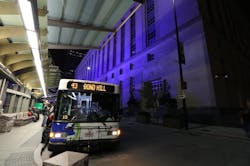Cincinnati makes ‘generational investment’ in transportation
Substantial new funding for transportation and infrastructure is coming to Cincinnati’s Hamilton County following the passage of a ballot initiative from Cincinnati’s delayed March primary election.
The details of this ballot measure will have an even greater impact on the region than the projected $130 million per year for 25 years, according to Source Cincinnati, an area organization focused solely on raising the Cincinnati region's reputation.
“Cincinnati’s business leaders have a rich history of stepping [up] to the plate to solve the big, seemingly intractable problems in our community,” said Cincinnati Chamber President & CEO Jill Meyer. “Passing Issue 22 and Issue 7 is yet another example of that civic leadership on display.”
The initiative was a two-step process. The Southwest Ohio Regional Transit Authority (SORTA) is the public agency that provides transit bus service in Cincinnati’s Hamilton County. But unlike most public transit agencies which are primarily funded by sales tax, SORTA is largely funded by the city of Cincinnati’s earnings tax. This funding model has been in place since 1970, and the current effort was the fifth attempt in 50 years to transfer the funding burden from the city to the county.
In November 2019, city voters overwhelmingly approved Issue 22, the ballot measure that initiated a rollback of 0.3 percent of the city’s 2.1 percent earnings tax if Issue 7 were to be approved in the coming spring. Reducing the city’s earnings tax would help make Cincinnati more competitive in attracting businesses to move to the city. However, if voters were to reject Issue 7 in March, the city earnings tax would remain at its current rate.
Issue 7, on the county ballot, introduced both the decrease in the city of Cincinnati’s earnings tax and an increase in the county sales tax by 0.8 percent, with the new levy dedicated to expanding and operating the Cincinnati Metro bus system with more bus routes, higher frequency, longer service hours and bus rapid transit, plus infrastructure improvements such as bridge repair and safer roads. Although Hamilton County voters have a history of rejecting such proposals, a bipartisan coalition of local leaders and elected officials saw a better chance of approval with the sales tax going toward road and bridge improvements in addition to bus operations.
After the March 17 election was postponed for public health reasons, the unofficial count in April showed a margin of victory of only 625 votes – too close to call – and the levy’s fate rested in the outstanding absentee ballots and provisional ballots.
With all votes now counted, the region is celebrating.
“The Southwest Ohio Regional Transit Authority is appreciative of the confidence voters have placed in us by investing in the services we provide,” said Kreg Keesee, chair of the SORTA Board. “We look forward to working with the community to implement the Reinventing Metro Plan and to partner with local governments to fix critical infrastructure in Hamilton County.”
“After years of hard work, organizing and advocating for this change, Hamilton County voters made a generational investment in our roads, bridges and buses,” said Taylor Liggins, campaign manager for the Move Forward PAC.
The Move Forward campaign was supported by a broad and diverse coalition. Source Cincinnati says the Cincinnati Chamber put a stake in the ground that improving the transportation system was critical to the region’s economic growth.
“Hamilton County took an historic step by passing Issue 7 and investing in the future of our community,” Meyer said. “By saying yes to expanded funding for our transportation system, Hamilton County and the Cincinnati region are poised for growth and improved access to jobs, education, health care and all that our region has to offer. These investments are more important than ever as we restart our economy and get people to work.”
